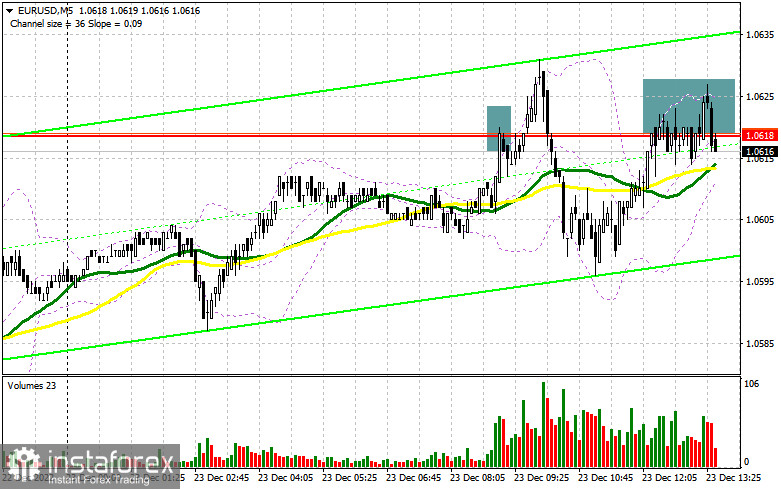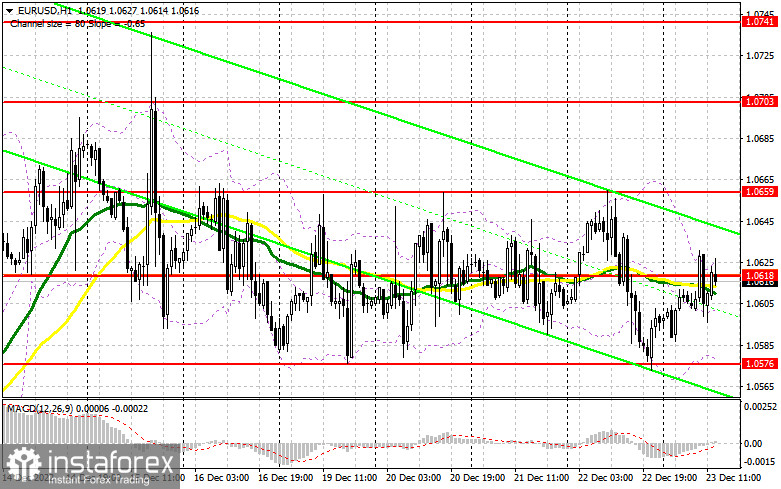
Long positions on EUR/USD:
For this reason, nothing has changed for the afternoon. During the North American session, the market expects a wide range of data: Personal Spending and Income indices, which influence US inflation, the Core PCE Price Index, the preferred indicator of the Federal Reserve System, and the New Home Sales index. If we see weak statistics, the euro may start a rally again, while strong data may give a sell signal and push the pair down to the lower boundary of the channel at 1.0576, which is the target. If the EUR/USD pair declines, a false breakout at 1.0576 is likely to create a signal to enter into long positions, betting on the price to return to 1.0618. Only a breakout and a top-down test of this level on the background of the weak US data may support bulls, allowing them to hit a new weekly high near 1.0659. If the price pierces this level, a new uptrend can start, opening the way to 1.0703 and 1.0740 with the prospect of reaching a monthly high of 1.0772, where traders may lock in profits. If the EUR/USD pair declines during the North American session, and we see weak bullish activity at 1.0576, the situation may reverse in favor of bears. In that case, only a false breakout near 1.0535 may give a buy signal. One may open long positions on a rebound from 1.0495, or lower near the low of 1.0445, allowing an upward intraday correction of 30-35 pips.
Short positions on EUR/USD:
Bears are still trying to drag the price lower but low volatility and trading volumes do not allow them to do this. Weak statistics on the US economy will force them to protect 1.0618 again. If a false breakout is formed there, similar to the signals, which were formed in the morning, this is likely to give an additional entry point into short positions with the target at the support of 1.0576. If the pair pierces this level, settles below it, and makes a downward test, this would give an additional signal, triggering bulls' Stop Loss orders and pushing the euro down to 1.0535. Bulls are protecting the lower boundary and are likely to enter the market again from there. The next target is located at 1.0495, where traders may take profits. If the EUR/USD pair rises during the North American session, and bears show weak activity at 1.0618, bears may lose confidence in their strengths, while buyers will have a good chance to hit a new high of 1.0659, the upper boundary of the sideways channel. Notably, the pair has been trading near this level during the week. It is better to sell EUR from this level after a false breakout. Short positions on the euro could be opened on a rebound from the high of 1.0703, allowing a downward correction of 30-35 pips.

According to the COT report from December 13, the number of both long and short positions dropped. Most traders decided to lock in profits before the meetings of the global central banks, which were held last week. This, in turn, led to a decline in the volume of positions. It is obvious that the hawkish policy chosen by the Fed and the ECB will continue to affect the growth of risk assets. The fact is that the intention of the central banks to combat inflation may lead to a recession in both the US and Europe. The COT report unveiled that the number of long non-commercial positions decreased by 8,648 to 236,415, whereas the number of short non-commercial positions dropped by 8,480 to 111, 700. At the end of the week, the total non-commercial net position became slightly smaller and amounted to 122,247 against 123,113. This indicates that investors remain balanced. Although they avoid buying the euro at the moment, they are not in a hurry to sell risky assets even at the current prices. A new fundamental reason is needed for further growth in the euro. The weekly closing price rose to 1.0342 from 1.0315.

Indicators' signals:
Moving averages
Trading is carried out near the 30- and 50-day moving averages. It indicates a sideways movement of the pair.
Note: The period and prices of moving averages are considered by the author on the H1 (1-hour) chart and differ from the general definition of the classic daily moving averages on the daily D1 chart.
Bollinger Bands
If the pair rises, the indicator's upper band at 1.0618 will offer resistance.
Description of indicators
- Moving average determines the current trend by smoothing out volatility and noise. Period 50. Marked in yellow on the chart.
- Moving average determines the current trend by smoothing out volatility and noise. Period 30. Marked in green on the chart.
- MACD indicator (Moving Average Convergence/Divergence — convergence/divergence of moving averages). Quick EMA 12. Slow EMA 26. SMA 9
- Bollinger Bands. Period 20
- Non-commercial speculative traders, such as individual traders, hedge funds, and large institutions that use the futures market for speculative purposes and meet certain requirements.
- Long non-commercial positions represent the total long open position of non-commercial traders.
- Short non-commercial positions represent the total short open position of non-commercial traders.
- Total non-commercial net position is the difference between the short and long positions of non-commercial traders.





















